610 Search Results for visual support
June 4, 2013
by Carole Zangari -
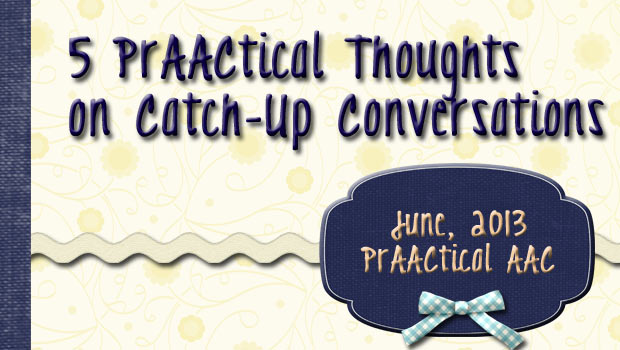
One of the things SLPs frequently do at the start of their therapy sessions is have some casual conversations with their clients to catch up on what happened since their last visit. Whether it is an elementary school student with ASD, a teenager with cerebral palsy, or an older adult with aphasia, we engage in polite conversation to find out what they’ve been up to and perhaps share a bit about our own experiences. Here are some thoughts on making those ‘catch-up conversations’ work from a prAACtical perspective. 1. Possible goal areas: initiate conversation; maintain dialogue on an established topic; redirect conversation to a new topic; respond to non-obligatory communication opportunities; use temporal terms in multi-word utterances; convey a personal narrative with a clear beginning, middle, and end; use regular past tense verbs; ask partner-focused questions 2. Core language targets: it, we, they, do/did, have/had, was/were, not It was (not);... [Read More...]
May 28, 2013
by Robin Parker -
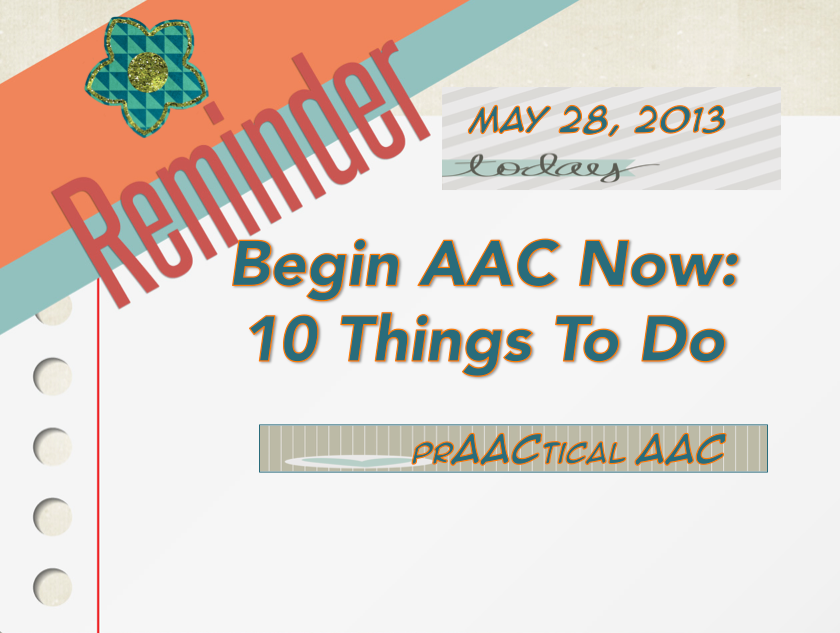
If you know someone with significant speech difficulties, BEGIN AAC NOW…. If you know someone, try something… Doing something, even if it isn’t perfect, is infinitely better than doing nothing at all…. There is no specific order for these suggestions, try what is appropriate and doable for you… A year from now you may wish you started today (K. Lamb)… So begin now at any level.. for someone, a class, a clinic, for a few… Create a Visual Language & AAC Environment: Visual Immersion Program, Meaningful Language Experiences, Importance of Using Visual Supports Speak AAC to the AAC Learner: Use Aided Language Input (ALI), Learning to Use ALI Get Assessment Information: Communication Matrix , AAC Evaluation Genie, Thoughts & Ideas, AAC Assessment Forms, Write & Implement Some AAC Goals: Goals That Matter, AAC in the IEP by Lauren Enders, PrAActical Goals Learn and Use a Core Word Approach: Core Word Communication Board Samples, About Core Words- First... [Read More...]
May 22, 2013
by Robin Parker -
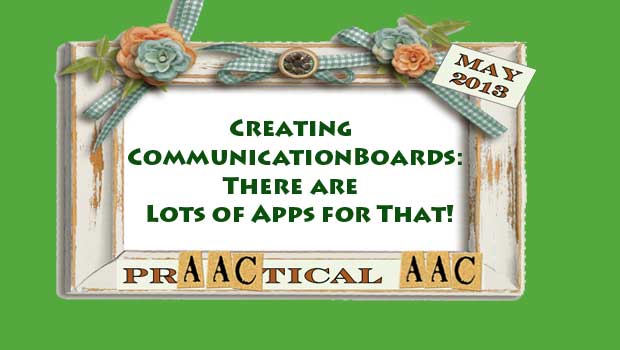
To continue on with the theme of the month, here are some app (and computer based) resources for easily creating your own communication boards: Pogo Boards Pogo Boards is a communication board creator for both the computer and the iOS platform. You can make traditional grid-based communication boards and a variety of other visual supports. Pogo Boards also has a variety of pre-made boards that users share. Price: – Free trial period with premium account, then Free basic account, Subscription price for ongoing premium account Symbly Go & Symbly Symbly is a computer based communication board creator. Communication boards are super easy to create, share, and print out. Symbly Go is an iOS platform app that allows you to view your communication boards (and other visual supports) on your iPad. Your communication boards will automatically be downloaded to your iPad (even when there’s no Internet connection available). There is text to speech capability if... [Read More...]
May 18, 2013
by Carole Zangari -
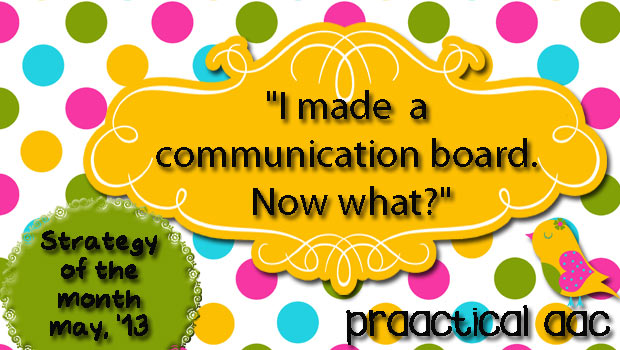
Earlier this month, we shared some ideas for making communication boards using color coding and also for creating boards geared to different communicative purposes. Making the communication board according to some basic principles is a good thing, of course, and it takes a decent amount of thought and planning. Even more important, though, is developing an intervention plan so that the augmentative communicator learns how to use the board effectively. Here are some of our thoughts on how to teach someone to use a new communication board. Model It We’ve talked about aided language input so many times that I’m almost embarrassed to mention it. Almost. The truth is, it is a ‘must do’ strategy when we’re first introducing a communication board, book, SGD, or AAC app. Incidental learning is important for just about all of the people with whom we work. It is never the only strategy we use,... [Read More...]
May 17, 2013
by Robin Parker -
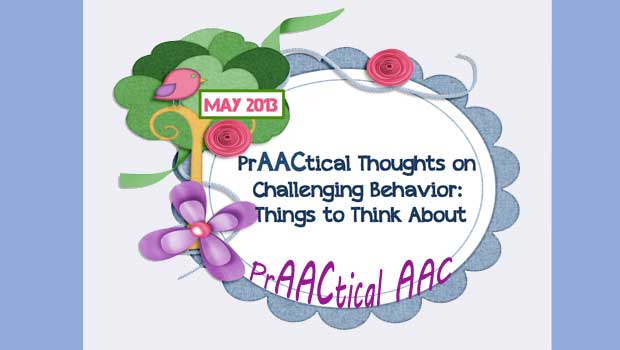
We have had several experiences in the last couple of weeks relating to concerns from SLP’s and educators about challenging behavior (dare we say it might be less structure, less predictability, less routines, or just plain tiredness because it is the end of the school year). Challenging behavior is hard… and disconcerting especially if you feel that you have little control over it (imagine how the learner feels- almost no one wants to be unhappy and out of control). However, there are so many strategies and supports that can improve the situation. It is often about getting back to basics (especially if end of the year issues play into the challenging behavior). The First 5 Questions to Ask: How Does the Learner Communicate? It is important that everyone has a way to communicate their own wants, needs, ideas, interests, and more. It is NOT good enough to just ‘know’ what someone... [Read More...]
May 13, 2013
by Carole Zangari -
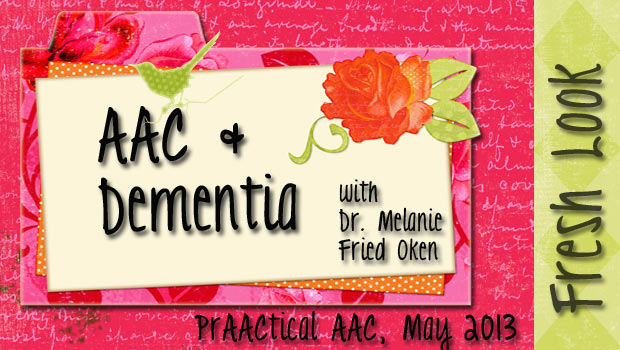
We’re thrilled to continue our Fresh Look series in celebration of Better Hearing and Speech Month (#BHSM). In this post, Dr. Melanie Fried Oken, from the Oregon Health and Science University, talks about some AAC strategies for people with dementia. I was captivated by her 2012 presentation on this topic at ISAAC 2012, and knew it was important to be able to share some of you work with you. We have much to offer these individuals with dementia, and Melanie’s post and linked resources are a great way to get started. ::::::::::::::::::::::::::::::::::::::::::::::::: Hey, what about us AAC providers who work with adults? We love reading PrAACtical AAC and can often adjust the tips, equipment recommendations, and strategies to meet our population needs. So when Carole gave me an opportunity to blog about AAC for adults with dementia, I grabbed the chance. I’d like to share with you some facts about... [Read More...]
May 4, 2013
by Carole Zangari -
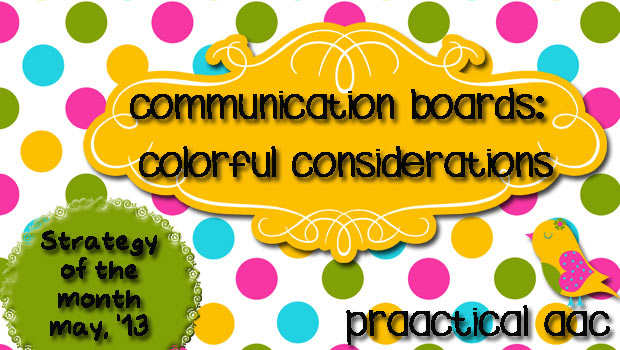
We love AAC technology and are deeply grateful for the options that are available to people with significant communication difficulties. We’re strong supporters of voice output systems and the autonomy they give to the children and adults with whom we work. On the other hand, we have great respect and much fondness for the “no tech” communication aids and visual supports. As a student clinician, I made my first conversation book for Sherri, a young lady who had learned Bliss at school but had no communication materials in the institution where she was living. In my days as a clinical fellow, I got ratted out by Davey, a client who used his 100-location Bliss board to tell the supervisor that I gave out seconds on coffee even though the rule was one cup per person. (I knew I should never have taught him interjections!) There’s no doubt – communication boards... [Read More...]
May 3, 2013
by Robin Parker -
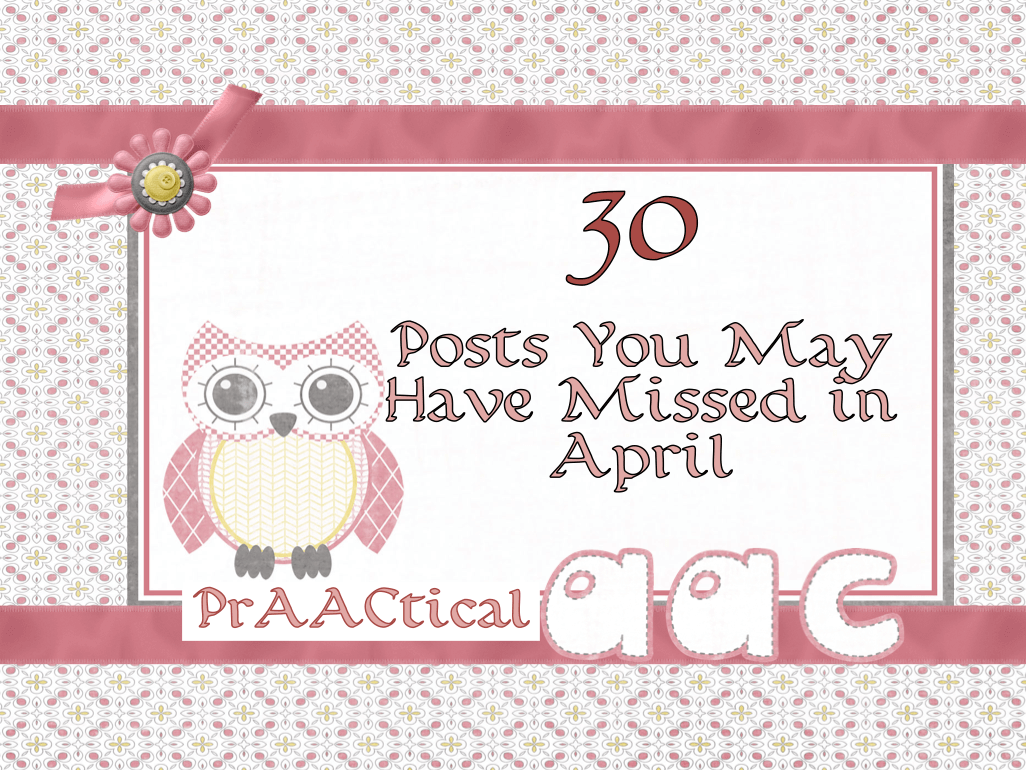
PrAACtical Thinking Happy April: Celebrate Autism Acceptance Month and National Poetry Writing Month Happy World Autism Day! 5 Ways to Get More Popular AAC Style 133 Free or Lite Versions of AAC Apps & App Selection Resources 5 Things To Do If You Are Not Confident Teaching Core Vocabulary 31 Posts You May Have Missed in March Communication Circles:With A Little Help From My Friends Core Vocabulary: Making Sense of Symbols AAC & RTI 5 Reasons for Using Pre-Stroed Messages in AAC Systems Speak To Me With Your Eyes My Love Keep Learning About Core Words: 8 More Things to do for Autism Acceptance Month A PrAACtical Look: AAC at the Baldwin Wallace Speech Center PrAACtical Goals That Matter 5 Ways to Use Powerpoint in AAC Intervention Strategy of The Month Teaching Core Vocabulary The First 12: Getting Started with Core Words More on Teaching Core Vocabulary More on Core... [Read More...]
April 22, 2013
by Robin Parker -
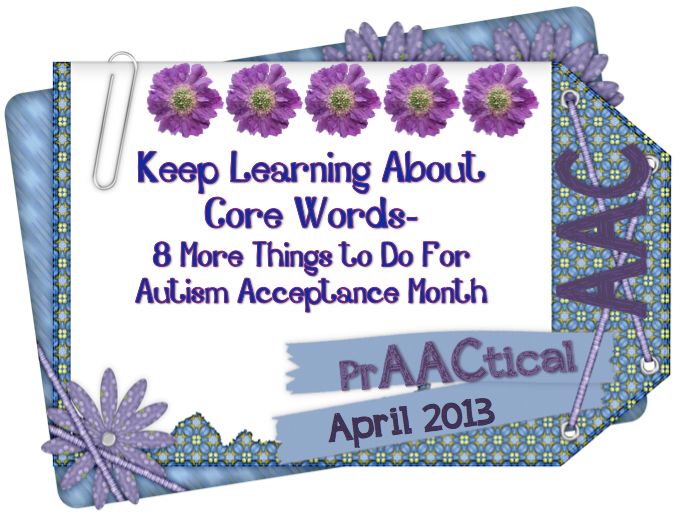
April is Autism Awareness/Acceptance month. It is exciting that there have been so many positive messages and activities around schools, communities, the country, and even the world. It has been great that AAC and visual supports have been incorporated into many educational and communication programs (hopefully soon a ‘tipping point’, so that ALL students who need AAC systems will have them). One of the next ‘tipping points’ that would also be great to see is with the use of core words on communication displays. ‘Core Words’ are our Strategy of the Month and we are writing about the first 12 through the first 36. But, if you want more background information or to go well beyond 36 core words (which is the goal), Here are 8 More Things To Do For Autism Acceptance Month: Take a look at AAC Language Lab for Core Word Information Read ASHA- A Few Good... [Read More...]
April 20, 2013
by Carole Zangari -
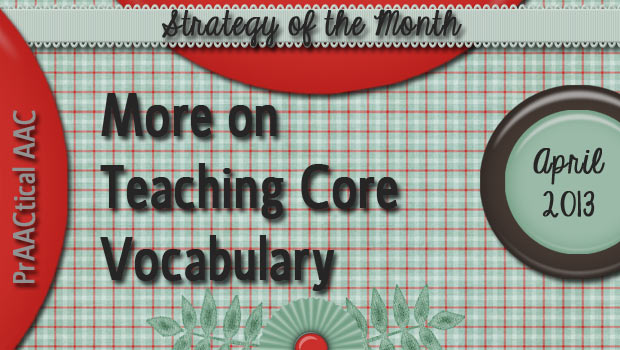
Last week, we talked about two key strategies for teaching core language: using aided language input and creating frequent opportunities to teach and elicit core words. In today’s post, we’ll expand the number of words and discuss two additional considerations for teaching core words. Aided language input is always important in working with beginning users of AAC. It exposes them to their new means of communication, provides them with a competent model of their AAC system, and introduces them to words and symbols they don’t yet know within a meaningful context. It also forces us to slow down when talking, something that can be very beneficial when you consider that many beginning users of AAC also have difficulty processing oral language. (It may take them longer to decode what they’re hearing and they may have to concentrate more than the average kid.) If you’ve actually tried pointing to symbols as... [Read More...]









